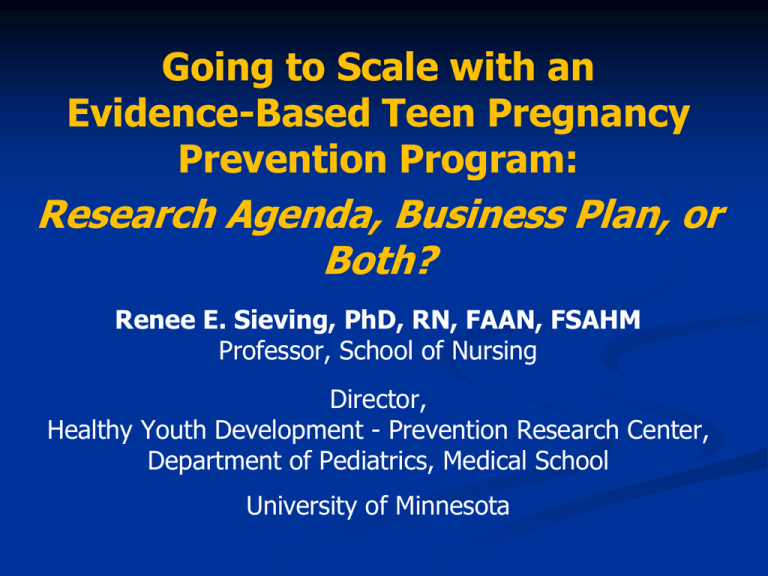
Going to Scale with an
Evidence-Based Teen Pregnancy
Prevention Program:
Research Agenda, Business Plan, or
Both?
Renee E. Sieving, PhD, RN, FAAN, FSAHM
Professor, School of Nursing
Director,
Healthy Youth Development - Prevention Research Center,
Department of Pediatrics, Medical School
University of Minnesota
Prime Time Research Team
Co-Is: L. Bearinger, A. Garwick, M. Resnick
Study Manager: K. Beckman
Intervention Coordinators: J. Oliphant, K. Rush
Evaluation Coordinator: S. Plowman
Analysis Team: B. McMorris, A.L. McRee,
A. Gower, M. Secor-Turner, A. Seppelt, R. Shlafer
Dissemination Team: G. Shea, J. Baumgartner
Teen Birth Rates: US, 1940-2010
MN Teen Birth Rates by Race/Ethnicity
Teen Pregnancy & Prevention
Teen pregnancy & childbearing are important public
health issues with substantial personal & public costs
Preventing early pregnancy among vulnerable youth
requires approaches that address diverse array of
psychosocial issues
Promise of youth development approaches
Prime Time
Youth development intervention designed for use by
primary care clinics
1-on-1 Case Management
+
Peer Leadership Groups
Aims to reduce precursors of teen pregnancy including
sexual risk behaviors and school disconnection
Prime Time
Intervention Guiding Framework
Youth as resources to be developed, rather
than problems to be fixed.
Building young women’s skills, confidence,
opportunities and social supports.
Prime Time Intervention Components
Case Management
1-on-1 teen-centered relationships
Topics: social & emotional skills; healthy relationships;
responsible sexual behaviors; positive family, school &
community involvement
Peer Leadership Groups
Multi-session training as peer health educators
Employ 16-session standardized curriculum
Pay teens to reach & teach others as peer educators
Prime Time Pilot Study
RCT with 128 participants (1999-2004)
Prime Time’s youth development approach is feasible &
acceptable to adolescent girls from urban, economically
challenged communities
Involvement in Prime Time associated with reductions in
risky sexual behaviors
Prime Time Efficacy Study
Design: Randomized controlled trial (2006-2011)
Setting: Community & school-based primary care clinics in
Minneapolis & Saint Paul, Minnesota
Study Sample
253 sexually active girls meeting specified risk criteria
Ages 13-17 years
Mean=15.6 years
Race/ethnicity
European
American
Mean # male sex partners:
1.7 in past 6 months
30.5% noted consistent
condom use, past 6
months
Mean hormonal method
use: 2 of past 6 months
American
Indian
2.8%
11.1%
Asian
Hispanic/
Latina
African
American
11.9%
41.1%
12.3%
20.9%
Multiple
Sexual Behavior Measures
Number of Male Sex Partners, Past 6 Months
Partner-Specific Sexual Behaviors
Condom Use Consistency, Past 6 Months
Hormonal Use Consistency, Past 6 Months
Dual Method Use Consistency, Past 6 Months
Outcomes Analyses
Analytic Sample
Participants completing study surveys at baseline and
follow-up point
Example: 237 teens completing surveys at baseline
and 30 month follow-up points (93.7% of full sample)
Analytic Approach
Each outcome regressed on participation in Prime Time
(intervention vs. control) controlling for baseline
measure of the outcome & adjusting for within-clinic
clustering
Prime Time Intervention Effects
12-month
survey
(intervention
interim point)
18-month
survey
(intervention
completion)
24-month
survey
(6 mo. post
intervention)
Condom use consistency
(p<.01)
(p<.01)
Hormonal use consistency
(p<.01)
(p<.01) (p<.01)
Dual method use consistency (p<.05)
(p<.05)
Recent sexual abstinence
Attending college/tech
school
30-month
survey
(12 mo. post
intervention)
(p<.01)
(p<.01)
(p<.05)
(p<.01)
(p<.01)
Intervention Effects:
Qualitative Case Exemplar
Discussion
Study addresses dearth of evidence re. long-term effects
of clinic-linked youth development interventions
Health services grounded in a youth development
framework hold great promise for preventing multiple risk
behaviors among youth most vulnerable to poor health
outcomes
Adolescent health services grounded in a youth
development frame can facilitate positive transitions into
adulthood
Planned Next Step,
Research-to Practice Agenda
Effectiveness study: Can Prime Time be successfully
implemented in natural settings by staff from youthserving clinics?
Comparison of full-strength intervention to partial-strength
intervention (CM only)
Participant self-reports & biomarkers; cost-effectiveness &
cost-benefit data
Context: ACA & expanded access and funding for
preventive services
“Prime Time Program added to Short List
of Effective Pregnancy Prevention
Programs Highlighted by Feds”
[February 2015]
http://z.umn.edu/primetime
Sources of Support
This research supported by:
NIH-NINR #R01-NR008778 (R. Sieving, PI)
CDC #U48-DP001939 (M. Resnick, PI)
BHP-HRSA #T32-HP22239 (I. Borowsky, PI)
University of Minnesota CTSI Dissemination Grant (R.
Sieving, PI)
Selected Prime Time Manuscripts
Ghobadzadeh M, Sieving R, Gloppen K (2015). Positive youth development and contraceptive use consistency. In
press, Journal of Pediatric Health Care.
Lando-King E, McRee A, Gower A, Schlafer R, McMorris B, Pettingell S, Sieving R (2015). Relationships between social
emotional intelligence and sexual risk behaviors in adolescent girls. In press, Journal of Sex Research.
Johnson A, Sieving R, Pettingell S, McRee AL (2015). The roles of partner communication and relationship status in
adolescent contraceptive use. Journal of Pediatric Health Care, 29, 61-69.
Secor-Turner M, Garwick A, Sieving R, Seppelt A (2014). Characteristics of violence among adolescent girls at high risk
for early pregnancy. Journal of Pediatric Health Care. 28, 227-233.
Sieving R, McRee AL, Secor-Turner M, Garwick A, Bearinger L, Beckman K, McMorris B, Resnick M (2014). Prime Time:
Long-term sexual health outcomes of a clinic-linked intervention. Persp Sexual & Reproductive Health, 46, 91-100.
Sieving R, McMorris B, Secor-Turner M, Garwick A, Shlafer R, Beckman K, Oliphant J, Pettingell S, Seppelt A (2014).
Prime Time: 18-month violence outcomes of a clinic-based intervention. Prevention Science, 15, 460-472.
Gower A, Shlafer R, Polan J, McRee AL, McMorris B, Pettingell S, Sieving R (2014). Brief report: Associations between
adolescent girls’ social emotional intelligence and violence perpetration. Journal of Adolescence, 37, 67-71.
Secor-Turner M, McMorris B, Sieving R, Bearinger L (2013). Life experiences of instability and sexual risk behaviors
among high risk adolescent girls. Perspectives on Sexual & Reproductive Health, 45, 101-107.
Selected Prime Time Manuscripts
Sieving R, McRee AL, McMorris B, Beckman K, Pettingell S, Bearinger L, Garwick A, Oliphant J, Plowman S, SecorTurner M, Resnick M (2013). Prime Time: 24-month sexual health outcomes of a clinic-linked intervention to prevent
pregnancy risk behaviors. JAMA Pediatrics, 167, 333-340.
Shlafer R, McMorris B, Sieving R, Gower A (2013).The impact of family and peer protective factors on girls’ violence
perpetration and victimization. Journal of Adolescent Health, 52, 365-371.
Tanner A, Secor-Turner M, Garwick A, Sieving R, Rush K (2012). Engaging vulnerable adolescents in a pregnancy
prevention program: Perspectives of Prime Time staff. Journal of Pediatric Health Care, 26(4), 254-265.
Sieving R, Bernat D, Resnick M, Oliphant J, Pettingell S, Plowman S, Skay C (2012). A clinic-based youth development
program to reduce sexual risk behaviors among adolescent girls: Prime Time pilot study. Health Promotion Practice,
13(4), 462-471.
Sieving R, McMorris B, Beckman K, Pettingell S, Secor-Turner M, Kugler K, Garwick A, Resnick M, Bearinger L (2011).
Prime Time: 12-month sexual health outcomes of a clinic-based intervention to prevent pregnancy risk behaviors.
Journal of Adolescent Health, 49,172-179.
Bearinger L, Sieving R, Duke N, McMorris B, Stoddard S, Pettingell S (2011). Adolescent condom use consistency over
time: Global versus partner-specific measures. Nursing Research, 60(3), S68-S78.
Sieving R, Resnick M, Garwick A, Bearinger L, Beckman K, Oliphant J, Plowman S, Rush K (2011). A clinic-based, youth
development approach to teen pregnancy prevention. American Journal of Health Behavior, 35(3), 346-358
Questions, ideas, suggestions? sievi001@umn.edu










